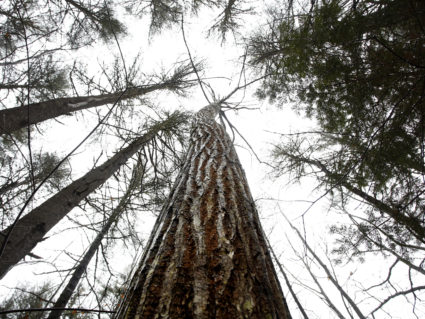
How 'America's perfect tree' was nearly wiped out
Our November pick for the PBS NewsHour-New York Times book club, "Now Read This" is Richard Powers' novel "The Overstory." Become a member of the book club by joining our Facebook group, or by signing up to our newsletter. Learn more about the book club here.
The novel "The Overstory" opens with a tale that revolves around a single American chestnut tree. It was once the dominant tree throughout much of the Eastern United States, bearing richly nutritious and sweet-tasting nuts, before a massive blight nearly wiped out the species.
Richard Powers, author of a dozen novels, masterfully weaves fact and fiction together throughout "The Overstory," his story about trees and the effect people have had on them over time. The book won the 2018 Pulitzer Prize.
Below, Powers annotates the beginning of the first chapter of "The Overstory," whose first line, about chestnuts, is adapted from the journal of Henry David Thoreau. To understand the true scale of the American chestnut tree, Powers suggests searching for images of the "giant Appalachian chestnut." The only true analogue may be the massive redwoods of the California coast.
From "The Overstory"
Nicholas Hoel
Now is the time of chestnuts.
People are hurling stones at the giant trunks. The nuts fall all around them in a divine hail. It happens in countless places this Sunday, from Georgia to Maine. Up in Concord, Thoreau takes part. He feels he is casting rocks at a sentient being, with a duller sense than his own, yet still a blood relation. Old trees are our parents, and our parents' parents, perchance. If you would learn the secrets of Nature, you must practice more humanity. . . .
In Brooklyn, on Prospect Hill, the new arrival, Jørgen Hoel, laughs at the hard rain his throws bring down. Each time his stone hits, food shakes down by the shovelful. Men dash about like thieves, stuffing caps, sacks, and trouser cuffs with nuts freed from their enclosing burrs. Here it is, the fabled free banquet of America–yet one more windfall in a country that takes even its scraps right from God's table.
The Norwegian and his friends from the Brooklyn Navy Yard eat their bounty roasted over great bonfires in a clearing in the woods. The charred nuts are comforting beyond words: sweet and savory, rich as a honeyed potato, earthy and mysterious all at once. The burred husks prickle, but their No is more of a tease than any real barrier. The nuts want to slip free of their spiny protection. Each one volunteers to be eaten, so others might be spread far afield.
That night, drunk on roasted chestnuts, Hoel proposes to Vi Powys, an Irish girl from the pine-framed row houses two blocks from his tenement, on the edge of Finn Town. No one within three thousand miles has the right to object. They marry before Christmas. By February, they are Americans. In the spring, the chestnuts bloom again, long, shaggy catkins waving in the wind like whitecaps on the glaucous Hudson.
This excerpt is taken from pp. 5-6.
Support Canvas
Sustain our coverage of culture, arts and literature.



















